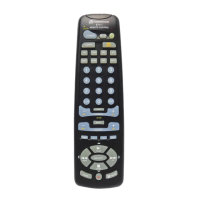77
77
7
66
66
6
HH
HH
H
OUSEOUSE
OUSEOUSE
OUSE
C C
C C
C
ODESODES
ODESODES
ODES
ANDAND
ANDAND
AND
U U
U U
U
NITNIT
NITNIT
NIT
C C
C C
C
ODESODES
ODESODES
ODES
Each Module has a specific address
made up of a House Code (red dial on
the face of the Module) and a Unit Code
(black dial on the face of the Module).
The Controller first sends an address and
then a command on the AC power lines.
Only the Module with a matching
address will execute the command. If
more than one Module has the same
address, both Modules will execute the
command.
Addresses are set on the Module by
turning the two dials on the front of the
Module to the desired letter and number
(using a small screwdriver or a coin). The
House Code is selected from the letters
A through P, and the Unit Code is
selected from the numbers 1 through 16.
UNIT CODE
DIAL
HOUSE CODE
DIAL
G G
G G
G
ETTINGETTING
ETTINGETTING
ETTING
S S
S S
S
TT
TT
T
ARAR
ARAR
AR
TEDTED
TEDTED
TED
Because we know that you are eager to
get started, we’ve kept this introduction
as short as possible, but it contains very
valuable information, so you should
read through it very carefully.
CC
CC
C
ONTROLLERSONTROLLERS
ONTROLLERSONTROLLERS
ONTROLLERS
ANDAND
ANDAND
AND
M M
M M
M
ODULESODULES
ODULESODULES
ODULES
The first thing you need to understand is
that there are two different devices you
need to control your house;
Controllers and Modules.
Any light or appliance that
you want to control is
plugged into a Module and
that Module is then plugged
into a standard AC outlet.
Modules receive commands
from Controllers. Examples
include the Lamp Module
(sold separately). The
Transceiver Module (also
sold separately) is another
example (although it also
doubles as a controller as
described later).
Controllers are plugged
into standard wall outlets
and send commands to
Modules over your existing
electrical wiring in your house
without affecting your electricity
in any way.
The Transceiver Module works
as a controller when it is used
with a remote control such
as the 8-in-1 Learning
SuperRemote. When the
Transceiver Module
receives a command from
the remote it sends digital
signals over your existing
house wiring to a Module
which receives the signals
and executes the command.
The remote uses radio frequency (RF)
signals to send commands to the
Transceiver Module. RF signals can go
right through walls, so you can use the
remote to control lights or appliances
from anywhere in your home.

